|
Kick Assiest Blog
Sunday, August 14, 2005
Christian lawfirms take on the ACLU
Mood:
 energetic
Topic: Yahoo Chat Stuff energetic
Topic: Yahoo Chat Stuff
Christian law firms are taking on the ACLU, focusing on the group's efforts to drive religion from all but the most private places.
Californians protesting the ACLU's effort to remove a Christian cross from the state seal. \/

'Anti-ACLU' Fights for Religion in Public Life
LOS ANGELES — For years, the American Civil Liberties Union and other groups have fought to remove any trace of religion from government and public life, and for years they've won.
Now the ACLU is facing a challenge from groups such as the Alliance Defense Fund, one of several Christian law firms formed in the 1990s.
From its base in Phoenix, the ADF says its goal is to defend religious liberty, the sanctity of human life and the traditional family against any person or group who attacks those principles.
"The ACLU has through the years filed a series of lawsuits that diminish the rights of Americans to understand their history, to exhibit in public, to exercise their faith in many ways," said ADF president and CEO Alan E. Sears.
In one of its better-known cases, the ADF sued the city and county of San Francisco and successfully argued before the California state Supreme Court that marriage licenses granted to same-sex couples should be declared null and void because the mayor and county clerk did not have the authority to issue them.
Now it's working on what it calls its "Christmas project," an effort to defend school districts around the nation against lawsuits to ban Christmas trees and other religious displays during the holidays.
Former ACLU board member Susan Estrich, a FOX News contributor, said groups such as the ADF are unnecessary because they represent a majority group, which already has all the influence it needs.
"So long as Christians are voting and electing the majority, and the majority of our leaders are Christian and the majority of our judges are Christian, I'm not sure who the Christians are ultimately complaining about," Estrich said.
Of course, it only takes one person to file a lawsuit. In San Diego, a single atheist has kept the city in court for over a decade trying to get a cross removed from a war memorial. The ADF and their allies say that's why they exist.
Fox News ~ Anita Vogel ** 'Anti-ACLU' Fights for Religion in Public Life
Posted by uhyw
at 7:39 PM EDT
Coward Deanpeace tells world U.S. is bluffing on force against Iran
Mood:
 chatty
Topic: Lib Loser Stories chatty
Topic: Lib Loser Stories
You might argue this is treason as it gives comfort to our enemies. Howard Dean told a television audience, in essence, that George W. Bush is bluffing about force in Iran. Of course, the Iranians may want to be careful about taking strategy advice from Howard Dean and the Democrats.
 Dean says Bush Iran position flaccid Dean says Bush Iran position flaccid
Democratic Party Chairman Howard Dean said President Bush has lost the credibility to make an effective threat against a nuclear Iran.
Appearing on CBS' Face The Nation Sunday, the former presidential candidate and Vermont governor said the president shouldn't make any threats he cannot deliver on.
The president ... doesn't have the capability to do anything in Iran, nor the international support ... because (of) extraordinary blunders so far in defending the country, he said.
Dean said the Iraq war committed the bulk of our military elsewhere and damaged the international support needed to back up a military threat against Iran.
But Dean also said the president's pledge to keep all options on the table regarding Iran is the proper course of action, and that he made similar statements during his 2004 White House run.
Web India 123.com ~ United Press International ** Dean says Bush Iran position flaccid
Posted by uhyw
at 7:19 PM EDT
Updated: Sunday, August 14, 2005 7:20 PM EDT
Record High Temps Hit Alaska... arctic bikini babe sightings
Mood:
 chatty
Topic: Yahoo Chat Stuff chatty
Topic: Yahoo Chat Stuff

Heat wave
A strong weather system brought record temperatures to the Interior on Wednesday and will keep things hot for several days.
Ted Fathauer, lead forecaster for the National Weather Service in Fairbanks, said the heat wave is due to a "fabulously strong high-pressure dome" aided by a cloudless sky. The high-pressure ridge responsible for the warm weather is of record proportions, according to the weather service, and it is expected to remain in place into the middle of next week.
Fathauer said the temperatures are unusual for this time of year.
"This is for real," Fathauer said. "It's not a meteorological practical joke."
The record high of 83 recorded Wednesday at Fairbanks International Airport was tied for highest temperature of the year with a day in June. Fathauer expected Thursday or today to be the warmest day of the year, until a smoky haze descended upon the area, keeping Thursday afternoon temperatures just under 80 degrees.
A dense smoke advisory was issued when the smoke from fires to the southwest drifted into the area.
Eielson Air Force Base recorded a temperature of 88 on Wednesday, breaking the 1990 record of 83. Several remote automatic stations reported temperatures into the 90s, with the highest reading of 92 at McKinley River southwest of Fairbanks.
Fathauer said garden plants should enjoy the temperatures, provided they are kept watered. He said mosquitoes are also enjoying the weather and should be propagating accordingly. But the warmth is too much for some.
"I talked with some visitors from a cruise ship and they said it was too hot," Fathauer said. "I told them I feel their pain."
Tanana Valley State Fair attendees seemed to be taking the heat in stride, general manager Lloyd Huskey said. He said there have not been any reported heat-related illness. Last year, three people had to be transported to the hospital from the fair for heatstroke. He said this year, many people are bringing in plenty of water and most of the concessions are also selling bottled water.
"It's warm but people seem to have taken very good notice," he said.
Superintendents and barn managers at the fairgrounds are taking a variety of measures to keep livestock comfortable during the heat wave.
At the Poultry Pavilion, the new "Cluck Hut" Quonset, poultry superintendent Cheryle Pfeffer had three different size wading pools set out for the ducks and geese. Inside, helpers were keeping the sawdust and gravel wetted down and ice was added to the water containers in each pen.
When it gets really warm, the poultry are misted with mister fans and their pens dampened.
"Next year, if it's hot, we're going to put iced water bottles in the pens," Pfeffer said.
At the Delta Barn, coordinator Kathy Bue said a large interior duct fan helps, but isn't cooling the barn adequately, despite the addition of a number of window fans strung overhead. The barn houses poultry, pigs, goats and calves.
"It's really tough on the animals," Bue said. "We're keeping them inside and not exercising them. We are misting them with water and making sure they have adequate water all day long."
Julie Hendrickson, who has a ram housed in the Delta Barn, cools him off by soaking him down to the skin at an outside hose.
She said her husband, a sheet-metal worker, has been looking over the barn and will volunteer to help install some wall fans at each end of the barn if someone will donate them.
There has been some horse stall switching the past few days as temperatures remain high.
"Some kids have been scratching if their animal is stressed from the heat," said Martha Kopplin, a superintendent for the 4-H Fair Horse Show.
After riding in the competitive events, riders take their steeds to the wash rack and hose them down. Others, Kopplin said, are exercising their horses during the late evening to keep them from standing too long in their stalls.
At the U.S. Youth Soccer Association Alaska State Cup taking place at the Fairbanks Youth Soccer Association fields this week, players aren't letting the heat affect their game.
"After the games, we're mostly in our rooms with the air conditioner on," said Jaymiee Jackson with the Anchorage Arsenal under-14 team. She and teammates Karly Meyer, Madeline Blake and Aurora Henriquez said a June trip to a Florida soccer tournament hardened them against the heat--that and the three bottles of water they are required to drink before and during games.
But the spectators didn't have the luxury of the shade tents the teams use on the sidelines. Karen Richards was watching her son 13-year-old son, Luke, with the AYSC Reds from Anchorage and said the kids seemed to be handling the heat better than most of the crowd.
"He's as wound up as ever," she said. "But I'm not sure how long I'm going to last."
Fairbanks Daily News-Miner ~ Margaret Friedenauer ** Heat wave
Posted by uhyw
at 7:14 PM EDT
Updated: Sunday, August 14, 2005 7:26 PM EDT
Bush protesting mom calls for ''Israel out of Palestine''; Vows not to pay taxes
Mood:
 spacey
Now Playing: Crawford protest mom: Imperialism, Impeachment and Israel
Topic: Lib Loser Stories spacey
Now Playing: Crawford protest mom: Imperialism, Impeachment and Israel
Topic: Lib Loser Stories
It's apparent slain Army Specialist Casey Sheehan and mom Cindy have very different values and that she is using the name of her dead son to advance an agenda she has probably always held. We all have political and cultural differences with family members. But it is unseemly for Ms. Sheehan to use the death of her son to express her radical views.
Ms. Sheehan believes that America is imperialistic, that Israel should leave Palestine (and go to Crawford maybe) that the President should be impeached. In short, the protest is perhaps less about her son?s sacrifice and her own profound loss and more about promoting her lifelong, anti-American viewpoint from atop a soap-box on her son's grave.
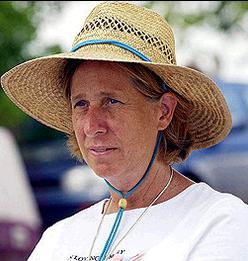 BUSH PROTESTING MOM CALLS FOR 'ISRAEL OUT OF PALESTINE'; VOWS NOT TO PAY TAXES BUSH PROTESTING MOM CALLS FOR 'ISRAEL OUT OF PALESTINE'; VOWS NOT TO PAY TAXES
Anti-war protestor Cindy Sheehan, whose soldier son Casey was killed in Iraq, is calling for Bush's "impeachment," and for Israel to get out of Palestine!
"You get America out of Iraq and Israel out of Palestine and you'll stop the terrorism," Sheehan declares.
Sheehan, who is asking for a second meeting with President Bush, says defiantly: "My son was killed in 2004. I am not paying my taxes for 2004. You killed my son, George Bush, and I don't owe you a penny...you give my son back and I'll pay my taxes. Come after me (for back taxes) and we'll put this war on trial."
"And now I'm going to use another 'I' word - impeachment - because we cannot have these people pardoned. They need to be tried on war crimes and go to jail."
The 48-year-old California mom remains tented up in a ditch along the one-lane road that leads to Bush's Texas ranch.
As her protest entered its second week, hundreds of people with conflicting opinions about the war in Iraq descended on the area.
 TIME mag reports in new editions on Monday: Sheehan gets support from her surviving son, Andy, in principle, but he recently sent her a long e-mail imploring her, "to come home because you need to support us at home."
Drudge Report Exclusive ** Bush Protesting Mom Calls for 'Israel Out of Palestine'; Vows Not to Pay Taxes
Posted by uhyw
at 7:10 PM EDT
Updated: Monday, August 15, 2005 11:04 PM EDT
Libtards Lag Conservatives in Blog Presence
Mood:
 chatty
Topic: Yahoo Chat Stuff chatty
Topic: Yahoo Chat Stuff
 Liberals lag conservatives in political blog presence Liberals lag conservatives in political blog presence
Liberal activist Web loggers have made major advances on the Internet, but they remain far behind their conservative adversaries among the top 250 political blogs, according to a study by a Democratic think tank.
In a detailed report on the political power being wielded by bloggers, who have become a potent force in national and state campaigns, the study found that while liberals have "a decided advantage" over conservatives among the top 40 blogs (24-16), "conservatives hold a whopping 133 to 77 advantage" among the next 210 blogs.
The study said this was "a serious problem that progressives must confront," if they are going to overcome the conservatives' advantage at the local level.
"An edge among small, local political blogs also means an edge in small, local, political races. While progressives may have a marked advantage in overall blogosphere discourse, it could also be argued that conservatives are taking a decisive lead in the sort of targeted blogging that will provide them with real, tangible benefits ...," the report says.
If liberal activists "do not invest time, energy and resources building a local blog infrastructure superior to that currently possessed by conservatives, the comparative advantage of progressives' overall traffic lead will be significantly reduced."
The study, "Emergence of the Progressive Blogosphere: A New Force in American Politics," was conducted by two Democratic bloggers for the New Politics Institute, a political think tank.
Among its chief findings is the explosive nature of the Internet's blogs, which have become the fastest-growing sector of the information industry.
"Since March of 2005, the total number of blogs has grown from 7.8 million to 14.2 million," the study says.
But it has been the political bloggers, particularly among conservatives, who have emerged as an effective organizing and fundraising force.
In the 2003 pre-election cycle, "Conservative bloggers vastly outpaced progressives in terms of total [readership] traffic. The top ranked blog, an influential conservative site known as Instapundit (www.instapundit.com), had as much traffic as the next five sites combined," the study says.
Since then, "the political dynamics of the Internet have reversed themselves," the study maintains. "In less than two years, the progressive blogosphere had grown from less than as big as the conservative blogosphere, to nearly double its size."
For example, the study said that while the conservative blog Instapundit was three times larger than any other blog two years ago, the largest liberal blog, Daily Kos (www.dailykos.com), is getting "more than four times as many monthly visits."
Even so, the study's authors said blogs on both sides are expanding. In the past two years, the number of hits or visits at the top 1,000 political blogs, conservative and liberal, has risen from 500,000 per day to more than 3 million.
According to a recent study by MyDD.com, a liberal political blog, 54.6 percent of conservative traffic and 69 percent of progressive traffic "went to the top 10 blogs representing their respective ideologies," the study says.
Washington Times ~ Donald Lambro ** Liberals lag conservatives in political blog presence
Posted by uhyw
at 8:42 AM EDT
Junk-science experts tweak Harry Reid
Mood:
 chatty
Topic: Lib Loser Stories chatty
Topic: Lib Loser Stories
 Harry Reid is screaming that the EPA's new radiation level standards near Yucca Mountain, the site of a controversial nuclear storage facility. Appealing to the NIMBY crowd (not in my back yard) Reid claims the standards will endanger people's lives. In truth, the standards are a fraction of what is detected at the Capitol building. That is just intended as an example. Radiation comes from a lot of sources, not just nuclear facilities.
Junk-science experts tweak Harry Reid
If U.S. Senator Harry Reid honestly thinks human beings would be at serious risk under the Environmental Protection Agency's new radiation standards, he should immediately start clamoring for an emergency program for the U.S. Capitol, where radiation exceeds those standards, say junk science specialists at the Cato Institute.

Reid lambasted newly proposed EPA standards Tuesday as the product of "voodoo science and arbitrary numbers," calling the criteria "the latest attempt by the Bush Administration to ignore sound science and disregard the health and safety of Nevadans."
The new EPA rules would limit exposure near the proposed Yucca Mountain facility in Nevada to 15 millirems a year for the next 10,000 years. Recently, researchers in Washington D.C. measured gamma radiation dose rates in a Capitol building hallway and outside the Thomas Jefferson Building. They found that individuals in those locations could receive anywhere from 60 millirems to 260 millirems of gamma radiation per year depending on the exposure scenario.
"These radiation dose rates are much higher than the EPA proposed to allow at the planned high-level nuclear waste repository at Yucca Mountain, Nevada," noted Cato Institute researcher Steven Milloy, who administers the Institute's junkscience.com website project.
"We hope that Sen. Reid will act immediately to protect Capitol building visitors, employees and future generations from this radiation hazard," said Milloy.
"We've asked Sen. Reid to undertake a comprehensive radiation survey of the Capitol and recommended that radiation hazard signs be used until the radiation sources can be removed and disposed in accordance with hazardous waste regulations," he added.
The study, Radiation Sources at the U.S. Capitol and Library of Congress Buildings, is by Milloy and Michael Gough, Ph.D. Gough is a member of the U.S. Department of Health and Human Services committee advising the U.S. Air Force on its study of the health effects of Agent Orange. The white paper, funded by a grant from Citizens for the Integrity of Science, is on-line at http://junkscience.com/apr01/crstudy.htm.
The Cato Institute defines "junk science" as "faulty scientific data and analysis used to further a special agenda." The junk science "mob," says junkscience.com, includes: media, personal injury lawyers, social activists, government regulators, businesses, politicians, individual scientists and individuals.
In June 2001, following initial publication by EPA of radiation standards for the Yucca Mountain repository, Reid, along with fellow Nevada senator John Ensign, had hailed the new standards as "a milestone in the battle to allow the Environmental Protection Agency (EPA) to carry out the law." Both senators praised the extremely low radiation limits regarding mountain groundwater—approximately 4 millirems annually, the same as drinking water.
However, within the month the state Nuclear Projects Agency and a consortium of environmental groups filed separate federal lawsuits, challenging the adequacy of the EPA's standards. State Nuclear Projects Agency chief Bob Loux said the EPA's radiation rule-making should not deal with expected conditions at Yucca Mountain for a mere 10,000 years into the future, but should be designed to protect people for at least 800,000 years.
In July 2004, the Court of Appeals for the District of Columbia Circuit upheld the EPA standards against the lawsuits on all counts except one: the 10,000-year time frame. Although recorded human history on this planet goes back less than 6,000 years, and though archeological records indicate that humans invented agriculture and settled down in cities only 10,000 years ago, a three-judge federal panel ruled that a million-year framework suggestion in a 1995 National Academy of Sciences report should be more strictly followed under a 1992 federal law.
The NAS report, "Technical Bases for Yucca Mountain Standards," had recommended that the standard should be applied "within the limits imposed by the long-term stability of the geologic environment, which is on the order of one million years."
In the EPA's original 2001 rulemaking, however, the agency had noted that it is not possible to make reliable estimates of repository performance over such a long time frame. Given such uncertainties, EPA had adopted instead a 10,000-year compliance period, noting that this was "the time frame used for the Waste Isolation Pilot Plant in New Mexico and for many international geologic disposal programs." It then included the million-year time frame within relevant technical advisory considerations.
However, in response to the 2004 court ruling, the EPA prepared its newly proposed standards and released them for review Tuesday. In addition to the original criteria for the first 10,000 years, the new standards now include a second "tier" for the next 999,990 years. That rule would limit exposure for someone living near Yucca Mountain some 10,001 years from now to a maximum of 350 millirem per year from the repository. Since normal background radiation for Americans today—mainly from natural sources—comes to about 350-360 millirem, the new standards would allow about 700 millirems exposure annually for a nearby rural resident. That is about the same amount of radiation that Americans living in high-altitude cities like Denver currently receive.
Thus, in the unlikely event that there is still a U.S. government existing 10,001 years from now, that government, under the new EPA standards, would be legally responsible for dealing with a situation where radiation emissions from the Yucca Mountain facility exceed 700-710 millirems annually for people living close by.
An unmentioned irony in all of the sparring is that nuclear industry observers expect nuclear "waste" stored at Yucca Mountain, should such storage even come nominally to pass, to be sold for re-processing within 20 years as a highly valuable commodity in an increasingly energy-hungry world. For more on the subject, see the Nevada Policy Research Institute's 2001 white paper, Spare the Rods: The Free-Market Alternative to the Yucca Mountain Repository, by D. Dowd Muska.
The EPA's full 217-page document released Tuesday—Public Health and Environmental Radiation Protection Standards for Yucca Mountain, Nevada—can be downloaded at http://www.epa.gov/radiation/docs/yucca/rin-2060-an15.pdf.
Common Voice ~ Steven Miller ** Junk-science experts tweak Harry Reid
Posted by uhyw
at 7:15 AM EDT
Updated: Sunday, August 14, 2005 7:23 AM EDT
The left was wrong (as usual) about landfills
Mood:
 smelly
Topic: Lib Loser Stories smelly
Topic: Lib Loser Stories
If you want to guarantee that you are wrong about something take a short term trend and plot it out way into the future. Then scream and yell with absolute certainty that it is fact and demand tax-payer bucks to avert calamity. This is what Dems do over and over and over and yet, collectively, we do not smarten up. A coming ice age, depletion of the world's oil, acid rain, the volume of nuclear waste, overpopulation, extinction of animal species, suburban sprawl, global warming, and of course, a shortage of landfill space.
For decades liberals demanded overpriced industrial laws, various consumption taxes and goofy recycling programs to counter what they claimed was a coming shortage of landfill space. They painted pictures of trash on barges and cities built upon landfills. Wrong again. As in all things supply and demand, with the aid of man's innovation, comes to the rescue. Do not be fooled again.
Rumors of a Shortage of Dump Space Were Greatly Exaggerated
Crews crushed trash at Fresh Kills in March, 2001. \/
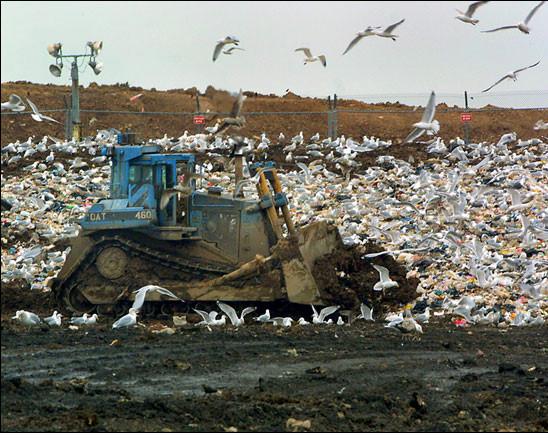
Workers at a landfill in Orange County, Calif. - as if tamping down the contents of a wastebasket - regularly pile one million cubic yards of dirt atop a football field-size section of the giant dump. Six months later, the workers scrape the dirt aside and the dump's surface has fallen 30 to 40 feet, making space for yet more trash.
"It's just amazing," said Mike Giancola, deputy director of the county's waste agency.
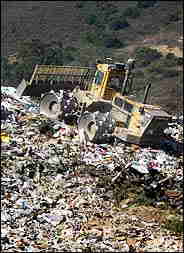 Crews crush trash at a dump in Orange County, Calif., where highly efficient compacting keeps the landfill from filling up. Crews crush trash at a dump in Orange County, Calif., where highly efficient compacting keeps the landfill from filling up. >>>>>
Orange County's method is part of a remarkable productivity story playing out in the trash business, quietly saving consumers, businesses and municipalities billions of dollars a year. It is an unlikely industry for such a leap in efficiency.
Simply put, operators of garbage dumps are stuffing more waste than anyone expected into the giant plastic-lined holes, keeping disposal prices down and making the construction of new landfills largely unnecessary.
The clearest winner in this development is the City of New York, which exports 25,000 tons of trash a day to other cities and states, making it the waste industry's biggest customer. But the benefits stretch coast to coast and will continue for years to come.
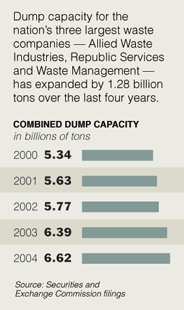 The productivity leap is the second major economic surprise from the trash business in the last 20 years. First, it became clear in the early 1990's that there was a glut of disposal space, not the widely believed shortage that had drawn headlines in the 1980's. Although many town dumps had closed, they were replaced by fewer, but huge, regional ones. That sent dumping prices plunging in many areas in the early 1990's and led to a long slump in the waste industry.
Since then, the industry and its followers have been relying on time - about 330 million tons of trash went into landfills in the United States last year alone, according to Solid Waste Digest, a trade publication - to fill up some of those holes, erase the glut and send disposal prices skyward again. Instead, dump capacity has kept growing, and rapidly, even as only a few new dumps were built.
How could that be? Waste companies and municipalities have fit much bigger dumps than originally permitted onto existing acreage, piling trash deeper and steeper, and vastly expanding permitted capacity. They are burying trash more tightly, so that each ton takes up less space, increasingly using giant 59-ton compacting machines guided by global positioning systems that show the operator when he has rolled over a section of the dump enough times. They cover trash at the end of the day, to keep it from blowing away, with tarps or foam or lawn clippings instead of the thick layers of soil that formerly ate up dump capacity.
Some operators are blowing water and air into landfills to hasten rotting and thus the shrinkage of buried garbage piles, creating more capacity.
Each practice is fairly prosaic, and many operators have yet to adopt the improved methods, but taken together the waste industry is in the early stages of the kind of increase in efficiency more typically seen in technologies like computer chips and turbines that generate electricity.
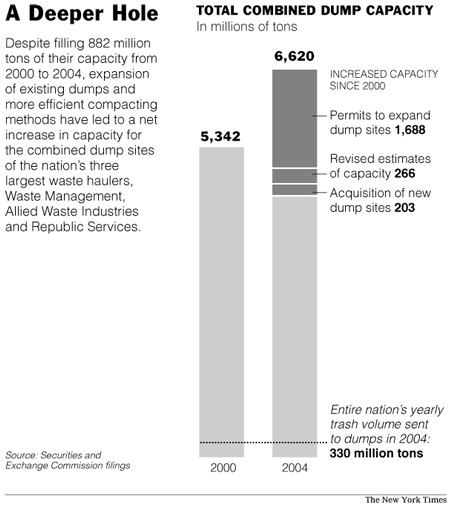
A well-run dump, tightly packed and using minimal dirt as cover, can hold 30 percent or so more trash than a poorly run site, said Thomas M. Yanoschak, a senior project manager at Camp Dresser & McKee, an engineering firm that advises waste sites. "Operators are much better now," he said.
The change is shown in the published disposal records of the three largest waste haulers - Waste Management, Allied Waste Industries and Republic Services - which combined handle more than half the nation's trash. In the last four years, they buried 882 million tons of waste. But the remaining permitted capacity of their combined 410 dumps did not shrink. It expanded over those four years by more than one billion tons. The three companies now expect expansions of another 1.8 billion tons. At that level, their combined capacity could handle the nation's trash sent to dumps for about 26 years.
Smaller companies and municipalities possess huge capacity, too. Taken together, the oversupply is a damper on prices. The nation's average gate rate, the price dumps post publicly, has lagged inflation, rising just 21 percent from 1992, when the original disposal glut first became widely known, to last year, climbing to $35 a ton from $29, according to Solid Waste Digest. Most businesses pay haulers directly for disposal. Many consumers pay through property taxes.
At $35 a ton, the 330 million tons buried nationally cost $11.6 billion. (Actual prices are typically lower than gate rates.) Had rates merely kept pace with inflation, disposal in dumps would average $39 a ton, or a collective $12.9 billion a year. And the annual cost would be $16.5 billion had prices, as widely predicted years ago based on an expected shortage, hit $50 a ton.
Dennis Pantano, chief operating officer at Regus Industries, a regional waste company based in West Seneca, N.Y., and a former executive at a national waste company, said he had expected "at least $45 to $50" by now. Instead, he said, "In Ohio we're still beating our heads against each other to get $18, $20 a ton - $25 in western New York. It really hasn't gone up in 10 years. That's obviously because of capacity."
Environmental regulations, which many feared would cause a disposal shortage, actually helped encourage the glut. The Resource Conservation and Recovery Act, passed in 1976 but put into effect over more than a decade, requires that liners be used to protect groundwater and that systems to extract water and methane be installed. The cost of all that forced thousands of small dumps to close and encouraged huge new landfills that could pile trash hundreds of feet deep to maximize the return on investment.
A 10,000-ton-a-year dump would cost $83 a ton to operate, estimates Solid Waste Digest, while a 300,000-ton-a-year site's cost would be $14 a ton. Dumps taking a million or more tons a year have even lower per-ton costs.
So, new replacement landfills were on average 25 times the size of the small ones that were closing, according to Solid Waste Digest. And even though the 8,000 dumps in 1988 fell to fewer than 1,800 today, according to the Environmental Protection Agency, capacity ballooned. Transfer stations, where trash is emptied from local collection trucks and reloaded onto bigger long-haul trucks or onto trains for transport to a dump, now number 3,700 nationally, a vast network extending the reach of giant disposal sites.
The nation's 25 biggest dumps, which are beginning to resemble operations in other more efficient and consolidated industries, account for about 24 percent of total capacity, Solid Waste Digest estimates, and that concentration will probably continue. Already, the Republic Services landfill in Las Vegas has more than 200 million tons of space, as does Waste Management's site in Arlington, Ore. And a desert site yet to begin accepting trash, owned by the Sanitation Districts of Los Angeles County, can hold more than 600 million tons, or enough to take 20,000 tons a day for 100 years.
Also, investment in railroad cars and containers for trash, still in its infancy, could further reduce transport costs and smooth out pricing disparities among regions. At present, disposal prices in the Northeast average about 2.5 times the cost to dump in the arid and little-populated Western states.
Owners of a recently built 210 million-ton-capacity landfill in Idaho are proposing to use barges to ship much of Hawaii's trash to the West Coast and transport it by rail the remaining distance. Idaho Waste System's gate rate is just $16.50 a ton, said Grant Gauthier, a vice president, and its permit has no daily limit. The company is seeking to expand its permit to 420 million tons, even though it currently takes in just 800 tons a day.
If the glut depresses prices, why do waste companies keep expanding their dumps? One reason, for the companies with publicly traded stock, is an accounting rule. Companies must write off, or depreciate, their landfill investments based on the percentage of a site's capacity filled up each year. A dump costing $100 million to build, filled 10 percent, would require $10 million of depreciation, reducing pretax profit by that amount. They set aside funds for post-closing environmental monitoring on a similar as-used schedule.
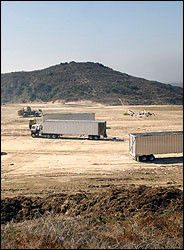 This Orange County, Calif., dump is stuffing more waste than anyone expected into its plastic-lined holes. This Orange County, Calif., dump is stuffing more waste than anyone expected into its plastic-lined holes. >>>>>
So, the more capacity that can be permitted at each dump, the less depreciation and other costs recorded per ton, lifting reported profits. Waste Management, of course, suffered an accounting scandal in the late 1990's, in part over landfill accounting, and was forced to take a $3.5 billion charge against earnings to clean up its books.
Once glamour stocks, waste companies have mostly been mediocre performers in recent years and the growing glut could prolong their problems, especially as municipalities and other major customers become more aware of the oversupply.
Indeed, the City of New York does not have a disposal problem. Initial bids to handle the trash hauled by the city for 20 years include per-ton prices at dumps in Virginia, South Carolina and Georgia of the mid-$20's to the mid-$30's, said Harry Szarpanski, assistant sanitation commissioner.
The problem is transportation. Shifting from trucks to rail and barges to reduce traffic, New York is taking on huge costs to develop a network of new transfer stations. That could increase prices to $90 a ton or so, Mr. Szarpanski said.
NY Times ~ Jeff Bailey ** Rumors of a Shortage of Dump Space Were Greatly Exaggerated
Posted by uhyw
at 12:01 AM EDT
Updated: Sunday, August 14, 2005 7:01 AM EDT
Saturday, August 13, 2005
1995 terror warning memo covered up
Mood:
 don't ask
Topic: Lib Loser Stories don't ask
Topic: Lib Loser Stories
It has become accepted wisdom that a contributing factor in the 9/11 attacks was a lack of coordination, even competition, between various law enforcement and intelligence organizations. Clinton administration Deputy Attorney General Jamie Gorelick, who later served on the 9/11 commision, created the policy that seperated the organizations.
This led U.S. Attorney for New York's Southern District Mary Jo White to write a memo in 1995 that warned the Justice Department that Gorelick's policy would hamper U.S. counterterrorism efforts. The Commision apparently covered up this memo.
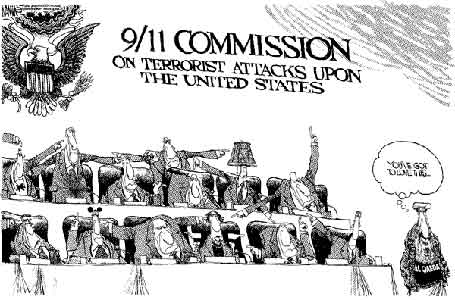
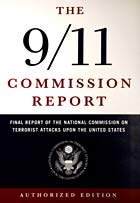 9/11 Commission Covered Up Gorelick Warning 9/11 Commission Covered Up Gorelick Warning
A 1995 memo from a top terrorism prosecutor warning that a directive by Clinton administration Deputy Attorney General Jamie Gorelick "could cost lives" is being concealed by the 9/11 Commission.
Compounding the cover-up, Gorelick herself was a prominent member of the Commission and refused to recuse herself from parts of the 9/11 investigation that covered the now notorious "wall" she erected that prevented intelligence and law enforcement agencies from cooperating in the war on terror.
In June 1995, U.S. Attorney for New York's Southern District Mary Jo White warned the Justice Department that Gorelick's prohibition against intelligence sharing would hamper U.S. counterterrorism efforts.
"It is hard to be totally comfortable with instructions to the FBI prohibiting contact with the United States Attorney's Offices when such prohibitions are not legally required," White wrote on June 13, 1995, in a memo reported Friday by the New York Post's Deborah Orin.
"The most effective way to combat terrorism is with as few labels and walls as possible so that wherever permissible, the right and left hands are communicating," advised White, who was then in the midst of prosecuting the 1993 World Trade Center bombers.
According to Orin, however, "White was so upset that she bitterly protested with another memo - a scathing one" - blasting Gorelick's wall of separation.
 While the former Clinton official and her fellow 9/11 commissioners have so far declined to make the second memo public, the Post reports that White used it to warn that Gorelick's wall "hindered law enforcement and could cost lives."
The 9/11 Commission omitted any mention of White's scathing second warning to Gorelick from its final report.
"Nor does the report include the transcript of its staff interview with White," the Post said.
The revelation that the 9/11 Commission covered up White's full account comes on the heels of news that Gorelick's wall may have prevented the FBI from learning that lead 9/11 hijackers Mohamed Atta and Marwan al-Shehhi had entered the U.S. and had been identified by military intelligence as terrorist threats a year before the attacks.
On Wednesday, Rep. Curt Weldon, who uncovered the Atta-al-Shehhi revelation, complained: "There was no reason not to share this information with the FBI, except that the firewalls that existed back then were so severe that they wouldn't let these agencies talk to one another."
News Max.com ~ Carl Limbacher ** 9/11 Commission Covered Up Gorelick Warning
Posted by uhyw
at 12:01 AM EDT
U.S. Forces Raid Iraq Chemical Facility
Mood:
 chatty
Topic: News chatty
Topic: News
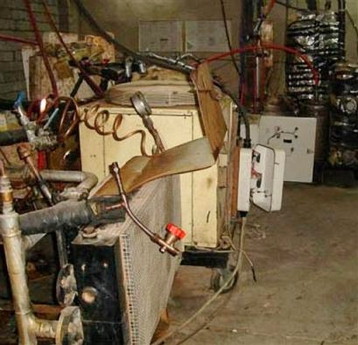 In this undated photo provided by the U.S. military, chemical production equipment is seen after U.S. troops raided as suspected chemical productions facility in northern Iraq. More than 1500 gallons of various chemicals were found at the site. >>>>>
U.S. Raids Suspected Chem Facility in Iraq
BAGHDAD, Iraq - U.S. troops raided a suspected insurgent chemical weapons factory in northern Iraq, finding about 1,500 gallons of dangerous substances, the U.S. military said Saturday.
Lt. Col. Steve Boylan, a military spokesman, said 11 chemicals were found in the hideout in Mosul, 225 miles northwest of Baghdad, "which are dangerous by themselves, and mixed together they would become even more dangerous."
"Our feeling at this point is that had this stuff been mixed and used, it could have been very easily used against Iraqi and coalition forces," Boylan said.
The military cautioned in a statement, however, that ongoing testing at the facility was "insufficient to determine what the insurgents had been producing" and that further tests were required.
U.S. troops, acting on a tip from detainees under interrogation, raided the building Tuesday, the statement said. The military did not say if anyone was detained in the raid and said it was investigating which insurgent group was operating the facility.
The military has found many suspected chemical sites in the past, none of which ended up containing chemical or biological weapons. Testing of such sites can take several days.
Boylan said the materials did not appear to be linked to Saddam Hussein's ousted regime.
The U.S. invaded Iraq in March 2003 to destroy Saddam's purported unconventional weapons of mass destruction. None were ever found.
U.S. arms investigators have said there was evidence that Iraqi resistance groups had tried to manufacture chemical weapons. The information was disclosed in the final report of Charles A. Duelfer's Iraq Survey Group, the account of its fruitless 18-month hunt for weapons of mass destruction in Iraq.
In an annex to the Duelfer report, the joint CIA - Pentagon teams told of having broken up an insurgent group in June 2004 that for six months tried to make weapons agents.
The group had recruited a Baghdad chemist and obtained chemicals from farmers who looted state companies and from shops in Baghdad's chemicals market, the report said. They first tried to make tabun, a nerve agent, but could not get the ingredients. Then the chemist, who had no weapons-making experience, was unable to manufacture the blistering agent mustard, although he had the right chemicals, the report said.
The insurgents hired another chemist, who succeeded in making ricin base, a poisonous plant extract, from castor beans, but at that point a U.S. raid on the laboratory, at Baghdad's al-Abud trading complex, disrupted the network.
The Duelfer account also said various sources reported insurgents were trying to produce chemical weapons elsewhere in Iraq.
In November, U.S. and Iraqi forces that overran Fallujah reported finding an insurgent lab which included the poisonous industrial compound hydrogen cyanide and a book of instructions for making potential chemical weapons.
Weeks earlier, Jordanian authorities said they had foiled planned chemical attacks by suicide bombers on Jordanian government targets. They said the plot was conceived by Abu-Musab al-Zarqawi, leader of the al-Qaida wing in Iraq.
Yahoo News ~ Associated Press - Antonio Castaneda ** U.S. Raids Suspected Chem Facility in Iraq
Posted by uhyw
at 12:01 AM EDT
Friday, August 12, 2005
Atta Details Omitted From Sept. 11 Report
Mood:
 on fire
Topic: Lib Loser Stories on fire
Topic: Lib Loser Stories
 Atta Details Omitted From Sept. 11 Report Atta Details Omitted From Sept. 11 Report
WASHINGTON - The Sept. 11 commission knew military intelligence officials had identified lead hijacker Mohamed Atta as a member of al-Qaida who might be part of U.S.-based terror cell more than a year before the terror attacks but decided not to include that in its final report, a spokesman acknowledged Thursday.
Al Felzenberg, spokesman for the commission's follow-up project called the 9/11 Public Discourse Project, had said earlier this week that the panel was unaware of intelligence specifically naming Atta. But he said subsequent information provided Wednesday confirmed that the commission had been aware of the intelligence.
The information did not make it into the final report because it was not consistent with what the commission knew about Atta's whereabouts before the attacks, Felzenberg said.
The intelligence about Atta recently was disclosed by Rep. Curt Weldon, vice chairman of the House Armed Services and Homeland Security committees. The Pennsylvania Republican has expressed anger that the intelligence never was forwarded by the military establishment to the FBI.
The discourse project, Pentagon and at least two congressional committees are looking into the issue. If found accurate, the intelligence would change the timeline for when government officials first became aware of Atta's links to al-Qaida.
According to Weldon, a classified military intelligence unit called "Able Danger" identified Atta and three other hijackers in 1999 as potential members of a terrorist cell in New York City. Weldon said Pentagon lawyers rejected the unit's recommendation that the information be turned over to the FBI in 2000.
According to Pentagon documents, the information was not shared because of concerns about pursuing information on "U.S. persons," a legal term that includes U.S. citizens as well as foreigners legally admitted to the country.
Felzenberg said an unidentified person working with Weldon came forward Wednesday and described a meeting 10 days before the panel's report was issued last July. During it, a military official urged commission staffers to include a reference to the intelligence on Atta in the final report.
Felzenberg said checks were made and the details of the July 12, 2004, meeting were confirmed. Previous to that, Felzenberg said it was believed commission staffers knew about Able Danger from a meeting with military officials in Afghanistan during which no mention was made of Atta or the other three hijackers.
Staff members now are searching documents in the National Archives to look for notes from the meeting in Afghanistan and any other possible references to Atta and Able Danger, Felzenberg said.
Felzenberg sought to minimize the significance of the new information.
"Even if it were valid, it would've joined the lists of dozens of other instances where information was not shared," Felzenberg said. "There was a major problem with intelligence sharing."
Weldon on Wednesday wrote to Thomas Kean, chairman of the 9/11 commission, and Lee Hamilton, the vice chairman, asking for information to be sought that would look at why the information was not passed on by Pentagon lawyers to the FBI.
His letter also asks the commissioners to find out why the panel's staff members did not pass the information about Able Danger onto commission members and provide full documentation.
Kansas Sen. Pat Roberts, chairman of the Senate Intelligence Committee, and his House counterpart, Michigan Rep. Peter Hoekstra, are looking into the issue.

News Max.com ~ Associated Press ** Atta Details Omitted From Sept. 11 Report
Posted by uhyw
at 6:57 PM EDT
Newer | Latest | Older
|


 Dean says Bush Iran position flaccid
Democratic Party Chairman Howard Dean said President Bush has lost the credibility to make an effective threat against a nuclear Iran.
Appearing on CBS' Face The Nation Sunday, the former presidential candidate and Vermont governor said the president shouldn't make any threats he cannot deliver on.
The president ... doesn't have the capability to do anything in Iran, nor the international support ... because (of) extraordinary blunders so far in defending the country, he said.
Dean said the Iraq war committed the bulk of our military elsewhere and damaged the international support needed to back up a military threat against Iran.
But Dean also said the president's pledge to keep all options on the table regarding Iran is the proper course of action, and that he made similar statements during his 2004 White House run.
Dean says Bush Iran position flaccid
Democratic Party Chairman Howard Dean said President Bush has lost the credibility to make an effective threat against a nuclear Iran.
Appearing on CBS' Face The Nation Sunday, the former presidential candidate and Vermont governor said the president shouldn't make any threats he cannot deliver on.
The president ... doesn't have the capability to do anything in Iran, nor the international support ... because (of) extraordinary blunders so far in defending the country, he said.
Dean said the Iraq war committed the bulk of our military elsewhere and damaged the international support needed to back up a military threat against Iran.
But Dean also said the president's pledge to keep all options on the table regarding Iran is the proper course of action, and that he made similar statements during his 2004 White House run.

 BUSH PROTESTING MOM CALLS FOR 'ISRAEL OUT OF PALESTINE'; VOWS NOT TO PAY TAXES
Anti-war protestor Cindy Sheehan, whose soldier son Casey was killed in Iraq, is calling for Bush's "impeachment," and for Israel to get out of Palestine!
"You get America out of Iraq and Israel out of Palestine and you'll stop the terrorism," Sheehan declares.
Sheehan, who is asking for a second meeting with President Bush, says defiantly: "My son was killed in 2004. I am not paying my taxes for 2004. You killed my son, George Bush, and I don't owe you a penny...you give my son back and I'll pay my taxes. Come after me (for back taxes) and we'll put this war on trial."
"And now I'm going to use another 'I' word - impeachment - because we cannot have these people pardoned. They need to be tried on war crimes and go to jail."
The 48-year-old California mom remains tented up in a ditch along the one-lane road that leads to Bush's Texas ranch.
As her protest entered its second week, hundreds of people with conflicting opinions about the war in Iraq descended on the area.
BUSH PROTESTING MOM CALLS FOR 'ISRAEL OUT OF PALESTINE'; VOWS NOT TO PAY TAXES
Anti-war protestor Cindy Sheehan, whose soldier son Casey was killed in Iraq, is calling for Bush's "impeachment," and for Israel to get out of Palestine!
"You get America out of Iraq and Israel out of Palestine and you'll stop the terrorism," Sheehan declares.
Sheehan, who is asking for a second meeting with President Bush, says defiantly: "My son was killed in 2004. I am not paying my taxes for 2004. You killed my son, George Bush, and I don't owe you a penny...you give my son back and I'll pay my taxes. Come after me (for back taxes) and we'll put this war on trial."
"And now I'm going to use another 'I' word - impeachment - because we cannot have these people pardoned. They need to be tried on war crimes and go to jail."
The 48-year-old California mom remains tented up in a ditch along the one-lane road that leads to Bush's Texas ranch.
As her protest entered its second week, hundreds of people with conflicting opinions about the war in Iraq descended on the area.
 TIME mag reports in new editions on Monday: Sheehan gets support from her surviving son, Andy, in principle, but he recently sent her a long e-mail imploring her, "to come home because you need to support us at home."
TIME mag reports in new editions on Monday: Sheehan gets support from her surviving son, Andy, in principle, but he recently sent her a long e-mail imploring her, "to come home because you need to support us at home."
 Liberals lag conservatives in political blog presence
Liberal activist Web loggers have made major advances on the Internet, but they remain far behind their conservative adversaries among the top 250 political blogs, according to a study by a Democratic think tank.
In a detailed report on the political power being wielded by bloggers, who have become a potent force in national and state campaigns, the study found that while liberals have "a decided advantage" over conservatives among the top 40 blogs (24-16), "conservatives hold a whopping 133 to 77 advantage" among the next 210 blogs.
The study said this was "a serious problem that progressives must confront," if they are going to overcome the conservatives' advantage at the local level.
"An edge among small, local political blogs also means an edge in small, local, political races. While progressives may have a marked advantage in overall blogosphere discourse, it could also be argued that conservatives are taking a decisive lead in the sort of targeted blogging that will provide them with real, tangible benefits ...," the report says.
If liberal activists "do not invest time, energy and resources building a local blog infrastructure superior to that currently possessed by conservatives, the comparative advantage of progressives' overall traffic lead will be significantly reduced."
The study, "Emergence of the Progressive Blogosphere: A New Force in American Politics," was conducted by two Democratic bloggers for the New Politics Institute, a political think tank.
Among its chief findings is the explosive nature of the Internet's blogs, which have become the fastest-growing sector of the information industry.
"Since March of 2005, the total number of blogs has grown from 7.8 million to 14.2 million," the study says.
But it has been the political bloggers, particularly among conservatives, who have emerged as an effective organizing and fundraising force.
In the 2003 pre-election cycle, "Conservative bloggers vastly outpaced progressives in terms of total [readership] traffic. The top ranked blog, an influential conservative site known as Instapundit (www.instapundit.com), had as much traffic as the next five sites combined," the study says.
Since then, "the political dynamics of the Internet have reversed themselves," the study maintains. "In less than two years, the progressive blogosphere had grown from less than as big as the conservative blogosphere, to nearly double its size."
For example, the study said that while the conservative blog Instapundit was three times larger than any other blog two years ago, the largest liberal blog, Daily Kos (www.dailykos.com), is getting "more than four times as many monthly visits."
Even so, the study's authors said blogs on both sides are expanding. In the past two years, the number of hits or visits at the top 1,000 political blogs, conservative and liberal, has risen from 500,000 per day to more than 3 million.
According to a recent study by MyDD.com, a liberal political blog, 54.6 percent of conservative traffic and 69 percent of progressive traffic "went to the top 10 blogs representing their respective ideologies," the study says.
Liberals lag conservatives in political blog presence
Liberal activist Web loggers have made major advances on the Internet, but they remain far behind their conservative adversaries among the top 250 political blogs, according to a study by a Democratic think tank.
In a detailed report on the political power being wielded by bloggers, who have become a potent force in national and state campaigns, the study found that while liberals have "a decided advantage" over conservatives among the top 40 blogs (24-16), "conservatives hold a whopping 133 to 77 advantage" among the next 210 blogs.
The study said this was "a serious problem that progressives must confront," if they are going to overcome the conservatives' advantage at the local level.
"An edge among small, local political blogs also means an edge in small, local, political races. While progressives may have a marked advantage in overall blogosphere discourse, it could also be argued that conservatives are taking a decisive lead in the sort of targeted blogging that will provide them with real, tangible benefits ...," the report says.
If liberal activists "do not invest time, energy and resources building a local blog infrastructure superior to that currently possessed by conservatives, the comparative advantage of progressives' overall traffic lead will be significantly reduced."
The study, "Emergence of the Progressive Blogosphere: A New Force in American Politics," was conducted by two Democratic bloggers for the New Politics Institute, a political think tank.
Among its chief findings is the explosive nature of the Internet's blogs, which have become the fastest-growing sector of the information industry.
"Since March of 2005, the total number of blogs has grown from 7.8 million to 14.2 million," the study says.
But it has been the political bloggers, particularly among conservatives, who have emerged as an effective organizing and fundraising force.
In the 2003 pre-election cycle, "Conservative bloggers vastly outpaced progressives in terms of total [readership] traffic. The top ranked blog, an influential conservative site known as Instapundit (www.instapundit.com), had as much traffic as the next five sites combined," the study says.
Since then, "the political dynamics of the Internet have reversed themselves," the study maintains. "In less than two years, the progressive blogosphere had grown from less than as big as the conservative blogosphere, to nearly double its size."
For example, the study said that while the conservative blog Instapundit was three times larger than any other blog two years ago, the largest liberal blog, Daily Kos (www.dailykos.com), is getting "more than four times as many monthly visits."
Even so, the study's authors said blogs on both sides are expanding. In the past two years, the number of hits or visits at the top 1,000 political blogs, conservative and liberal, has risen from 500,000 per day to more than 3 million.
According to a recent study by MyDD.com, a liberal political blog, 54.6 percent of conservative traffic and 69 percent of progressive traffic "went to the top 10 blogs representing their respective ideologies," the study says.
 Harry Reid is screaming that the EPA's new radiation level standards near Yucca Mountain, the site of a controversial nuclear storage facility. Appealing to the NIMBY crowd (not in my back yard) Reid claims the standards will endanger people's lives. In truth, the standards are a fraction of what is detected at the Capitol building. That is just intended as an example. Radiation comes from a lot of sources, not just nuclear facilities.
Junk-science experts tweak Harry Reid
If U.S. Senator Harry Reid honestly thinks human beings would be at serious risk under the Environmental Protection Agency's new radiation standards, he should immediately start clamoring for an emergency program for the U.S. Capitol, where radiation exceeds those standards, say junk science specialists at the Cato Institute.
Harry Reid is screaming that the EPA's new radiation level standards near Yucca Mountain, the site of a controversial nuclear storage facility. Appealing to the NIMBY crowd (not in my back yard) Reid claims the standards will endanger people's lives. In truth, the standards are a fraction of what is detected at the Capitol building. That is just intended as an example. Radiation comes from a lot of sources, not just nuclear facilities.
Junk-science experts tweak Harry Reid
If U.S. Senator Harry Reid honestly thinks human beings would be at serious risk under the Environmental Protection Agency's new radiation standards, he should immediately start clamoring for an emergency program for the U.S. Capitol, where radiation exceeds those standards, say junk science specialists at the Cato Institute.


 Crews crush trash at a dump in Orange County, Calif., where highly efficient compacting keeps the landfill from filling up. >>>>>
Orange County's method is part of a remarkable productivity story playing out in the trash business, quietly saving consumers, businesses and municipalities billions of dollars a year. It is an unlikely industry for such a leap in efficiency.
Simply put, operators of garbage dumps are stuffing more waste than anyone expected into the giant plastic-lined holes, keeping disposal prices down and making the construction of new landfills largely unnecessary.
The clearest winner in this development is the City of New York, which exports 25,000 tons of trash a day to other cities and states, making it the waste industry's biggest customer. But the benefits stretch coast to coast and will continue for years to come.
Crews crush trash at a dump in Orange County, Calif., where highly efficient compacting keeps the landfill from filling up. >>>>>
Orange County's method is part of a remarkable productivity story playing out in the trash business, quietly saving consumers, businesses and municipalities billions of dollars a year. It is an unlikely industry for such a leap in efficiency.
Simply put, operators of garbage dumps are stuffing more waste than anyone expected into the giant plastic-lined holes, keeping disposal prices down and making the construction of new landfills largely unnecessary.
The clearest winner in this development is the City of New York, which exports 25,000 tons of trash a day to other cities and states, making it the waste industry's biggest customer. But the benefits stretch coast to coast and will continue for years to come.
 The productivity leap is the second major economic surprise from the trash business in the last 20 years. First, it became clear in the early 1990's that there was a glut of disposal space, not the widely believed shortage that had drawn headlines in the 1980's. Although many town dumps had closed, they were replaced by fewer, but huge, regional ones. That sent dumping prices plunging in many areas in the early 1990's and led to a long slump in the waste industry.
Since then, the industry and its followers have been relying on time - about 330 million tons of trash went into landfills in the United States last year alone, according to Solid Waste Digest, a trade publication - to fill up some of those holes, erase the glut and send disposal prices skyward again. Instead, dump capacity has kept growing, and rapidly, even as only a few new dumps were built.
How could that be? Waste companies and municipalities have fit much bigger dumps than originally permitted onto existing acreage, piling trash deeper and steeper, and vastly expanding permitted capacity. They are burying trash more tightly, so that each ton takes up less space, increasingly using giant 59-ton compacting machines guided by global positioning systems that show the operator when he has rolled over a section of the dump enough times. They cover trash at the end of the day, to keep it from blowing away, with tarps or foam or lawn clippings instead of the thick layers of soil that formerly ate up dump capacity.
Some operators are blowing water and air into landfills to hasten rotting and thus the shrinkage of buried garbage piles, creating more capacity.
Each practice is fairly prosaic, and many operators have yet to adopt the improved methods, but taken together the waste industry is in the early stages of the kind of increase in efficiency more typically seen in technologies like computer chips and turbines that generate electricity.
The productivity leap is the second major economic surprise from the trash business in the last 20 years. First, it became clear in the early 1990's that there was a glut of disposal space, not the widely believed shortage that had drawn headlines in the 1980's. Although many town dumps had closed, they were replaced by fewer, but huge, regional ones. That sent dumping prices plunging in many areas in the early 1990's and led to a long slump in the waste industry.
Since then, the industry and its followers have been relying on time - about 330 million tons of trash went into landfills in the United States last year alone, according to Solid Waste Digest, a trade publication - to fill up some of those holes, erase the glut and send disposal prices skyward again. Instead, dump capacity has kept growing, and rapidly, even as only a few new dumps were built.
How could that be? Waste companies and municipalities have fit much bigger dumps than originally permitted onto existing acreage, piling trash deeper and steeper, and vastly expanding permitted capacity. They are burying trash more tightly, so that each ton takes up less space, increasingly using giant 59-ton compacting machines guided by global positioning systems that show the operator when he has rolled over a section of the dump enough times. They cover trash at the end of the day, to keep it from blowing away, with tarps or foam or lawn clippings instead of the thick layers of soil that formerly ate up dump capacity.
Some operators are blowing water and air into landfills to hasten rotting and thus the shrinkage of buried garbage piles, creating more capacity.
Each practice is fairly prosaic, and many operators have yet to adopt the improved methods, but taken together the waste industry is in the early stages of the kind of increase in efficiency more typically seen in technologies like computer chips and turbines that generate electricity.

 This Orange County, Calif., dump is stuffing more waste than anyone expected into its plastic-lined holes. >>>>>
So, the more capacity that can be permitted at each dump, the less depreciation and other costs recorded per ton, lifting reported profits. Waste Management, of course, suffered an accounting scandal in the late 1990's, in part over landfill accounting, and was forced to take a $3.5 billion charge against earnings to clean up its books.
Once glamour stocks, waste companies have mostly been mediocre performers in recent years and the growing glut could prolong their problems, especially as municipalities and other major customers become more aware of the oversupply.
Indeed, the City of New York does not have a disposal problem. Initial bids to handle the trash hauled by the city for 20 years include per-ton prices at dumps in Virginia, South Carolina and Georgia of the mid-$20's to the mid-$30's, said Harry Szarpanski, assistant sanitation commissioner.
The problem is transportation. Shifting from trucks to rail and barges to reduce traffic, New York is taking on huge costs to develop a network of new transfer stations. That could increase prices to $90 a ton or so, Mr. Szarpanski said.
This Orange County, Calif., dump is stuffing more waste than anyone expected into its plastic-lined holes. >>>>>
So, the more capacity that can be permitted at each dump, the less depreciation and other costs recorded per ton, lifting reported profits. Waste Management, of course, suffered an accounting scandal in the late 1990's, in part over landfill accounting, and was forced to take a $3.5 billion charge against earnings to clean up its books.
Once glamour stocks, waste companies have mostly been mediocre performers in recent years and the growing glut could prolong their problems, especially as municipalities and other major customers become more aware of the oversupply.
Indeed, the City of New York does not have a disposal problem. Initial bids to handle the trash hauled by the city for 20 years include per-ton prices at dumps in Virginia, South Carolina and Georgia of the mid-$20's to the mid-$30's, said Harry Szarpanski, assistant sanitation commissioner.
The problem is transportation. Shifting from trucks to rail and barges to reduce traffic, New York is taking on huge costs to develop a network of new transfer stations. That could increase prices to $90 a ton or so, Mr. Szarpanski said.

 9/11 Commission Covered Up Gorelick Warning
9/11 Commission Covered Up Gorelick Warning
 While the former Clinton official and her fellow 9/11 commissioners have so far declined to make the second memo public, the Post reports that White used it to warn that Gorelick's wall "hindered law enforcement and could cost lives."
The 9/11 Commission omitted any mention of White's scathing second warning to Gorelick from its final report.
"Nor does the report include the transcript of its staff interview with White," the Post said.
The revelation that the 9/11 Commission covered up White's full account comes on the heels of news that Gorelick's wall may have prevented the FBI from learning that lead 9/11 hijackers Mohamed Atta and Marwan al-Shehhi had entered the U.S. and had been identified by military intelligence as terrorist threats a year before the attacks.
On Wednesday, Rep. Curt Weldon, who uncovered the Atta-al-Shehhi revelation, complained: "There was no reason not to share this information with the FBI, except that the firewalls that existed back then were so severe that they wouldn't let these agencies talk to one another."
While the former Clinton official and her fellow 9/11 commissioners have so far declined to make the second memo public, the Post reports that White used it to warn that Gorelick's wall "hindered law enforcement and could cost lives."
The 9/11 Commission omitted any mention of White's scathing second warning to Gorelick from its final report.
"Nor does the report include the transcript of its staff interview with White," the Post said.
The revelation that the 9/11 Commission covered up White's full account comes on the heels of news that Gorelick's wall may have prevented the FBI from learning that lead 9/11 hijackers Mohamed Atta and Marwan al-Shehhi had entered the U.S. and had been identified by military intelligence as terrorist threats a year before the attacks.
On Wednesday, Rep. Curt Weldon, who uncovered the Atta-al-Shehhi revelation, complained: "There was no reason not to share this information with the FBI, except that the firewalls that existed back then were so severe that they wouldn't let these agencies talk to one another."
 In this undated photo provided by the U.S. military, chemical production equipment is seen after U.S. troops raided as suspected chemical productions facility in northern Iraq. More than 1500 gallons of various chemicals were found at the site. >>>>>
U.S. Raids Suspected Chem Facility in Iraq
BAGHDAD, Iraq - U.S. troops raided a suspected insurgent chemical weapons factory in northern
In this undated photo provided by the U.S. military, chemical production equipment is seen after U.S. troops raided as suspected chemical productions facility in northern Iraq. More than 1500 gallons of various chemicals were found at the site. >>>>>
U.S. Raids Suspected Chem Facility in Iraq
BAGHDAD, Iraq - U.S. troops raided a suspected insurgent chemical weapons factory in northern